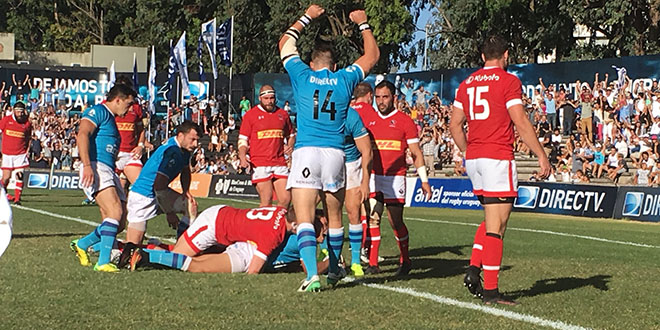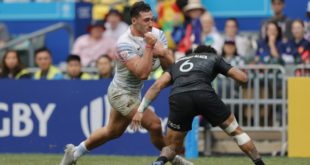Uruguay has been a success story of the past decade. Los Teros returned from missing out on Rugby World Cups 2007 and 2011 to now be a consolidated participant. For Uruguay, the focus changed from qualifying for World Cups to a sustainable long-term structure. How this happened may offer a pathway to others.
Uruguay’s first taste at the World Cup was a success. Los Teros debuted with a 27-15 win over Spain in Scotland in 1999. Four years on Uruguay were 24-12 winners over Georgia in Australia. While there were some professional players, the backbone of Los Teros’ first two campaigns was the amateur domestic system. Indeed, Uruguay lost matches against fully-professional teams in 1999 and 2003.
Uruguay were unfortunate to miss out on a place at RWC 2007. An early red card to Juan Bado cost the team. Los Teros won 18-12 against Portugal but missed out on aggregate by 24-23.
Disappointment continued in the RWC 2011 qualifiers. Again, with an opportunity of securing the final place, Uruguay missed out. Romania rebounded from a 21-21 draw in Montevideo to produce an emphatic 39-12 win in Bucharest in 2010.
Bucharest was the turning point for Uruguay. It was clear that change was needed for Uruguay to return to the World Cup. A plan was pieced in to action. It took time and was not ready for the RWC 2015 qualifiers.
Uruguay overcame Russia 57–49 on aggregate to qualify for RWC 2015. The 36–27 home win in the return fixture was crucial for what followed. Star forward Rodrigo Capó Ortega returned to play in the series. Pro D2 player Agustín Ormaechea had been the highest profile name to face the USA in earlier qualifiers.
Capó Ortega did not play at the World Cup. Ormaechea was one of four players not based in Uruguay. The URU made the decision to invest in the players. It was the start of a High Performance regime. The players were better prepared for the World Cup than in 2003. Uruguay was winless; yet, the losses were reduced in comparative terms to those from RWC 2003.
With fitter, stronger and better-prepared players, Los Teros were progressing. A missing piece that fell into place following RWC 2015 was the Americas Rugby Championship (ARC). Uruguay needed more matches in general, more against higher ranked teams and to play more multi-dimensional rugby. The ARC performed this role perfectly.
Progression came in the RWC 2019 qualifiers. Uruguay qualified as Americas 2 by defeating Canada home-and-away. Uruguay would add to the 38-29 win in Vancouver with a 32-25 win over the USA in Seattle in the 2019 ARC.
In addition to the ARC was the arrival of Major League Rugby (MLR). This meant that while the number of Uruguayans in Europe remained largely unchanged, there were opportunities elsewhere. Three RWC 2019 Teros played in France, one in England and ten in MLR. The remainder were busy at the High Performance Center at Montevideo.
Uruguay’s famous 30-27 win over Fiji at RWC 2019 came as a shock to many. Had Fiji underestimated Uruguay? Yes. Did Fiji play poorly? No. The story was how Los Teros won the game not how Fiji lost. Investments had decreased the uphill slope that Uruguay had fought against in prior RWC cycles.
The arrival of professional rugby in Uruguay was the next step forward. Peñarol Rugby became the first professional team and the Súper Liga Americana de Rugby (SLAR) was the competition. Peñarol were second in 2021 and champions in 2022.
With professional players to call-upon from home and abroad Uruguay had what was unthinkable a decade earlier. Los Teros qualified for RWC 2023 as Americas 1. It came with an aggregate win over the USA. The decisive match was a 34-15 home win.
Los Teros have more players abroad now. Santiago Arata, and Manuel Leindekar play in the Top 14, German Kessler, Nicolas Freitas and Andrés Vilaseca play in the Pro D2 and Agustin Ormaechea and Felipe Berchesi in lower divisions. The French-based names are joined by professionals in Italy and the Americas.
Regional collaboration came in the ARC and in SLAR. In 2023 it is coming with the rebranding of SLAR to Super Rugby Americas. Leadership is an additional factor of note; the Estadio Charrúa has hosted international numerous fixtures and tournaments.
Progress has come with the domestic game continuing to be the heart-beat. The grassroots is what contributes players who can filter though the system to High Performance. This is happening with the club came remaining strong. Meanwhile, the URU is busy seeking new pathways for development. Los Teros Sevens earning a place on the World Rugby Sevens Series is a case in point.
Everything Uruguay has done has been with homegrown players. There are not Argentines, New Zealanders, South Africans or others who qualify via residency or heritage. Uruguay’s 2022 test match against Tonga raised-eyebrows. All Blacks Malakai Fekitoa, Vaea Fifita, George Moala and Augustine Pulu started as did New Zealanders William Havili, Zane Kapeli, Sam Moli, Ben Tameifuna, and Anzelo Tuitavuki and Australian Afusipa Taumoepeau.
That match was a week after an important result. Twelve years after the disappointment of losing 39-12 in Bucharest, Uruguay won 21-16. It was the second win out of three tests for the year against Romania. In short, over a twelve year-period Los Teros have arguably progressed to switch places with Canada to be level with Romania.
 Americas Rugby News Rugby news from across the Americas!
Americas Rugby News Rugby news from across the Americas!




